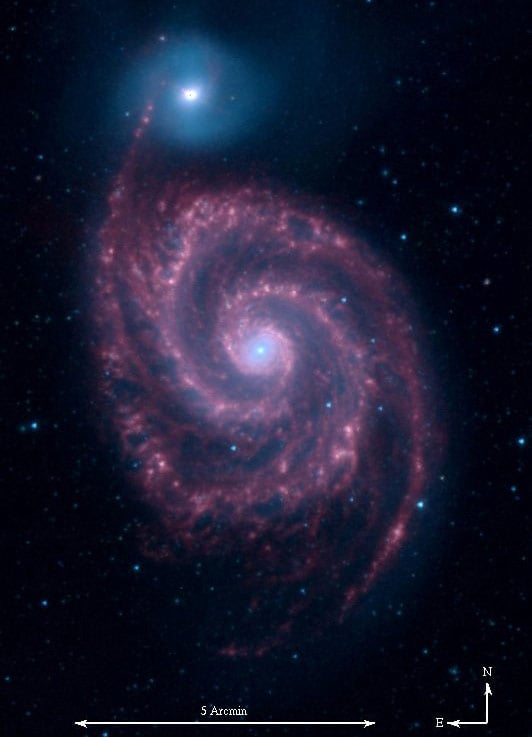
The interacting galaxies Messier 51A and B as seen in the infrared. Credit: NASA; L. Lanz
By combining computer simulations with multi-band observations, two new studies examine how luminosity, star formation, dust heating, and other effects evolve during a galaxy collision.
Nearly thirty years ago the Infrared Astronomy Satellite discovered that the universe contained many tremendously luminous galaxies, some more than a thousand times brighter than our own Milky Way, but which are practically invisible at optical wavelengths. They are powered by bursts of star formation buried deep within clouds of dust and gas; the dust absorbs the optical light while radiating at infrared wavelengths.
Astronomers suspect that in many cases the hyperactivity was triggered by a collisional encounter that facilitated the collapse of interstellar gas into new stars. Collisions between galaxies are common. Indeed, most galaxies have probably been involved in one or more encounters during their lifetimes, making these interactions an important phase in galaxy evolution and the formation of stars in the universe. The Milky Way, for example, is bound by gravity to the Andromeda galaxy and is approaching it at a speed of about 50 kilometers per second; we are expected to meet in another billion years or so. In the local universe, such encounters can be easily identified by the visible morphological distortions they produce such as tidal tails sweeping out from the galactic discs. But not all infrared luminous galaxies show such distortions; moreover, luminous galaxies in the more distant cosmos are too remote to detect these spatial signatures (at least with current telescopes). Astronomers are therefore working to understand when and how collisions stimulate star formation, whether that star formation resembles conventional star formation or differs (perhaps by making more massive stars, for example), and to determine if some alternative to visual morphology can also quantify these effects.
CfA astronomers Lauranne Lanz, Andreas Zezas, Howard Smith, Matt Ashby, Giovanni Fazio, Lars Hernquist, and Rafael Martinez-Galarza, together with their colleagues, have combined new multi-wavelength observations and computer simulations of interacting galaxies to study what is going on. They place particular emphasis on far infrared results from the Herschel Space Telescope which for the first time have enabled a detailed examination of the conditions of warm and cold dust in these objects. The galaxies they examine are from a sample that includes all stages of interaction, from early stages when disruption has only just begun to near final stages when the effects of the collision are prominent.
The scientists present their conclusions, the first such systematic comparisons between interacting galaxy observations and simulations, in two new papers. The first examines the effectiveness of the simulations, which after all can be no more accurate than the physics that has been included. The conclusion is that the simulations are quite good, at least with respect to the broad spectrum of an interaction and its evolution in time. The team also notes that the shape of the spectrum alone is generally insufficient to specify precisely the interaction stage, implying that other measurements will be needed to constrain the evolutionary stages of distant galaxies.
The second paper critiques a common method used for estimating the star formation rate in galaxies, namely, relating it simply to the luminosity (the idea being that more luminosity implies more star formation). The authors conclude from the simulations that during a galaxy’s post-merger evolution its infrared luminosity may be dominated by contributions from older stars rather than new ones, a feature that conventional models do not accurately account for. Thus, the standard method typically overestimates the rate of star birth, sometimes by a factor of as much as one hundred. Future planned work will propose alternative methods, as well as account more precisely for luminosity contributions from a supermassive black hole in the nucleus.
References:
“Simulated Galaxy Interactions as Probes of Merger Spectral Energy Distributions” by Lauranne Lanz, Christopher C. Hayward, Andreas Zezas, Howard A. Smith, Matthew L. N. Ashby, Nicola Brassington, Giovanni G. Fazio and Lars Hernquist, 24 March 2014, The Astrophysical Journal.
DOI: 10.1088/0004-637X/785/1/39
arXiv:1402.5151
“The Total Infrared Luminosity May Significantly Overestimate the Star Formation Rate of Recently Quenched Galaxies” by Christopher C. Hayward, Lauranne Lanz, Matthew L. N. Ashby, Giovanni Fazio, Lars Hernquist, Juan Rafael Martınez-Galarza, Kai Noeske, Howard A. Smith, Stijn Wuyts and Andreas Zezas, MNRAS.
DOI: 10.1093/mnras/stu1843
arXiv:1402.0006


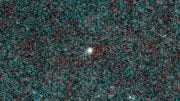
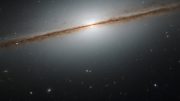


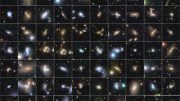
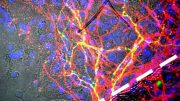

Be the first to comment on "Astronomers Examine Star Formation in Luminous, Colliding Galaxies"